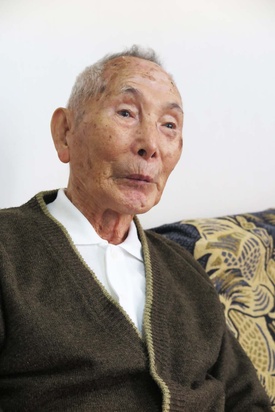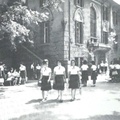“The Japanese language school was frozen and condemned by the Brazilian government as hostile property. It will be the true war’s end for me when the school gets returned to us the Nikkei.” This was what Arata Kami, who had led a campaign for getting the school back for over 20 years, all on his own, kept saying.
On June 18, the day of the 110th anniversary of Japanese immigration to Brazil, a ceremony was held to change title of the land of Santos Japanese School, and the school was officially handed back from the federal government to the local Japanese association. In other words, Kami’s ‘war’ finally came to an end 73 years after the end of WWII.
As newspaper O Estado de São Paulo reported on the 20th that “A key was given back after 76 years – the federal government returned the Japanese house condemned during wartime,” Brazilian media featured it as well.
Unfortunately, Kami himself had passed away right before on March 11, at the age of 95. But I could see him pushing himself upright and crying banzai in heaven.
Kami-san also supported me a lot as a local agent of Santos for Nikkey Shimbun (and also for then Paulista Shimbun) where I work, by taking on such tasks as collecting subscription fees or receiving complaints for a long time. From time to time he gave calls to the editorial department and boosted my morale, telling me, “You have to come and report Santos more often. Write a story about the campaign to get the Japanese school back.”
I still remember clearly when Kami-san took me to the gate of the Japanese school around 1992 right after I arrived in Brazil.
Back in the days, guards were standing in front as it was a military facility and for security protection even photography was prohibited. As a newcomer I was cowardly backing away, thinking the military might get me if I did something wrong.
But Kami-san pointed at the building with his head high and repeatedly said to me, “There, can you see the building at the back? That was the Japanese school. I’ve never got inside. It was condemned during the war and the army owns it. But it has to be returned to colonia someday. So please write about it.”
I remember that I was a bit scared with my heart beating fast, as the guards looked back at us suspiciously. And at the same time I wondered why Kami-san could be so courageous.
Strongly encouraged by Kami-san, I put the story on the top page of Paulista Shimbun, but in the back of my mind I was thinking, “It’s 99% impossible to make it come true even if I write such a story. Kami-san is like Don Quixote standing against the gigantic army alone.”
I was told that Kami-san had been doing editorial work and writing for the monthly newsletter Seinan since 1975 as part of activities of Santos Japanese Association. In the newsletter, he repeatedly wrote to promote friendship among members and also about the campaign to get the Japanese school back.
Appreciating his passion, the committee appointed him chairperson in 1978 and had him work for 25 years until 2003. Although the newsletter was put to an end in 1992 with its 200th issue, but they kept printing about 130 copies of the handwritten mimeographed version.
Looking back, he kept throwing ‘paper pellets’ of Japanese papers and newsletters with such perseverance during the time of fearful military dictatorship (1964 – 1985). Where did such power come from?
Japanese Papers Unwilling to Attack Government
For the 100th anniversary of Japanese immigration to Brazil, I took part in the editing of the chronicle of 100 years and wrote about the history of Japanese papers. What I became keenly aware of at the time was the fact that every Japanese paper was hesitant to criticize the Brazilian government. Japanese papers had gone through a traumatic experience of forced termination under the dictatorship of Getúlio Vargas in 1941. As the government executives allowed them to resume publication from 1946 in the immediate aftermath of the war, they made it a complete taboo to condemn the government as they thought that it would lead to termination of their business.
Such trend became more prominent during the military dictatorship (1964 – 1985) when the government assassinated, detained, and tortured anti-government activists and communists. Most Japanese papers were censored, so the management was summoned by the censor board for any suspicious act. I could feel that people still lived in such fear in 1992 when I arrived there.
For example, I remember the time right before when the federal police arrested a Japanese suspect in March, 1994, who was under international warrant for the violation of narcotic law in Japan.
An officer from the federal police once came to the editorial department of Paulista Shimbum where I worked as a reporter at the time because they got a notebook of the suspect and wanted us to translate what was written in it. I remember that there was an extreme tension in our department – an officer from the former DOPS (Department of Political and Social Order, similar to the Special Higher Police of Japan) is coming. This was nearly 10 years after the control of power was transferred to a civilian government.
I would assume that the “paper pellets” Kami-san threw at them didn’t even bother the government. But still, the call for the return definitely was a way of criticizing the government, and the one that threw the ball must have had a strong determination.
However, the world had changed before we realized. Once the Workers’ Party (PT - Partido dos Trabalhadores), eager to bring a charge against the intelligence agency of their assassination and torture of anti-government activists under military administration, came to power in 2003, things rapidly changed at once. By coincidence Kami-san gave up the post of chairperson to Hiroshi Endo that year, saying he had lost his strength and energy after passing the age 81.
Still, he had processed legal procedures of carrying out a signature-collection campaign and gathering papers for getting the school back by 1994. In 1994, he asked congressmember Koyu Iha, who was forced out of Santos himself and proposed a bill for complete return.
However, they had to keep waiting for the bill to be brought up, and even after federal congressmember João Paulo Papa helped label it “emergent” case, they had to wait for deliberation.
The 100th anniversary of Japanese immigration to Brazil was when things started to move suddenly. Two years before the anniversary, in December, 2006, chairperson Hiroshi Endo and the representative of the federal government national property bureau signed the contract that granted the “right of use” of the site to Santos Japanese Association.
But this was simply a voluntary handover of the “right of use,” and the property right was still in the hands of the federal government. The old building was renovated and brought to completion in June, 2008, when they invited Imperial Highness, and it was turned into a Japanese cultural center offering Japanese education.
This time, the name of the property right was changed and thus the return was completed.
© 2018 Masayuki Fukasawa






